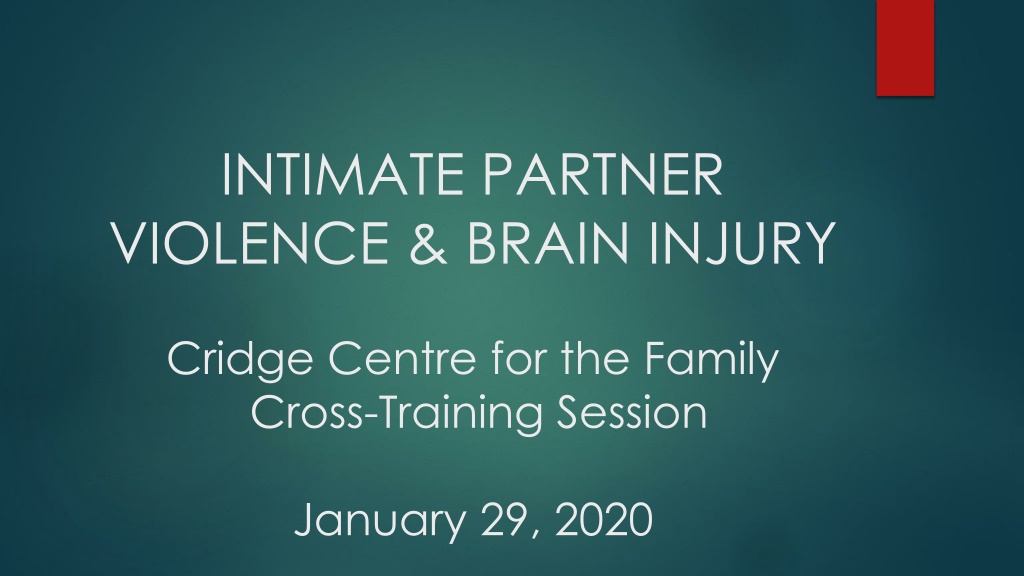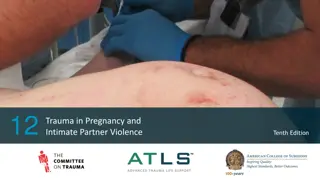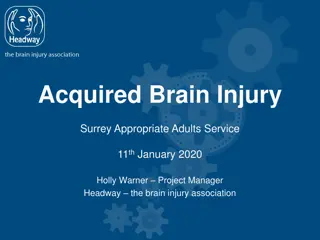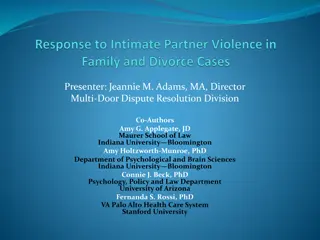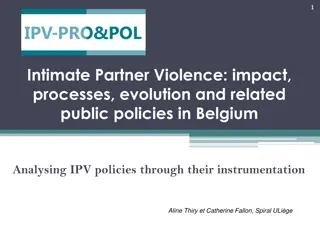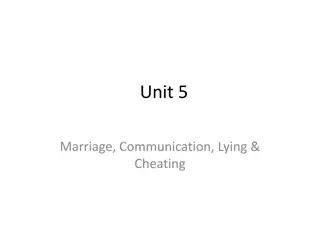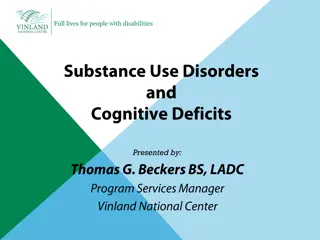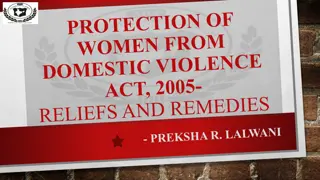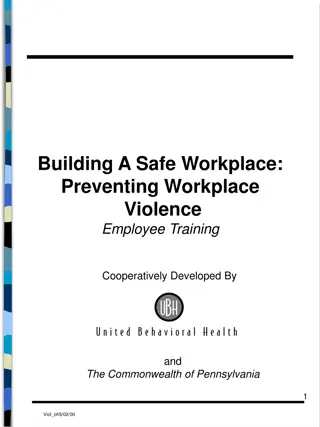Understanding Intimate Partner Violence and Brain Injury Connections
The link between intimate partner violence (IPV) and brain injury is significant, with studies showing a high prevalence of brain injuries among IPV survivors, particularly women. Common types of IPV causing brain injury include hits to the head, strangulation, and banging the head against objects. However, offering support to IPV and brain injury survivors faces challenges such as lack of formal diagnosis, funding, and knowledge. Initiatives like The Cridge IPV & BI Initiative aim to address these issues and provide better understanding and support to women survivors of IPV.
Download Presentation

Please find below an Image/Link to download the presentation.
The content on the website is provided AS IS for your information and personal use only. It may not be sold, licensed, or shared on other websites without obtaining consent from the author. Download presentation by click this link. If you encounter any issues during the download, it is possible that the publisher has removed the file from their server.
E N D
Presentation Transcript
INTIMATE PARTNER VIOLENCE & BRAIN INJURY Cridge Centre for the Family Cross-Training Session January 29, 2020
The Link Between IPV & BI Between 30%-90% of women who have experienced physical abuse have a brain injury of some kind Harvard University study (Valera, 2003): 75% of participants had at least one mild brain injury 50% had sustained repetitive brain injuries Ohio State study (Nemeth, 2019): 81% reported being hit on the head 50% reported so many blows to the head they couldn t keep track of the number 83% reported being choked or strangled Research in Canada- University of Toronto, University of Victoria, University of British Columbia Okanagan
Common Types Of Intimate Partner Violence Causing Brain Injury Up to 92% of IPV incidents involve one or more of the following: Hits or punches to the head or face Banging victim s head against a hard object like a wall, floor, or headboard Strangulation The obstruction of blood vessels and/or airflow in the neck, resulting in lack of oxygen to the brain (asphyxia) Loss of consciousness occurs at 6-7 seconds Often no visible signs of injury
Challenges Offering Support To IPV & BI Survivors Lack Of A Formal Diagnosis Insufficient funding for BI and IPV services Fear Of Brain Injury Being Weaponized Lack Of Knowledge and Collaboration
Intimate Partner Violence UNDERSTANDING AND SUPPORTING WOMEN SURVIVORS
Intimate Partner Violence in Canada Half of all women in Canada have experienced at least one incident of physical or sexual violence since the age of 16 (Canadian Women s Foundation, 2019) 74% of women killed in Canada in 2018 were killed by an intimate partner or family member (Canadian Femicide Observatory, 2019) 83% of intimate partner violence is perpetrated by men (Statistics Canada, 2017) 70 % of IPV is not reported to the police (Statistics Canada, 2017).
Dynamics of Intimate Partner Violence
Dynamics of Intimate Partner Violence
Your client Mira has just moved in with her boyfriend. You have very little information about the relationship, but your gut tells you that her boyfriend may be abusive. WHAT SIGNS OR PATTERNS MIGHT YOU BE LOOKING FOR TO HELP YOU ASSESS?
Intersecting Factors with IPV BRAIN INJURY: Up to 80% of women experiencing physical violence have a brain injury (Source: abitoolkit.ca) ADDICTION: Drug and alcohol addiction has been found to co-occur with IPV in 60-80% of victims (Source: American Society of Addiction Medicine) MENTAL HEALTH: IPV can lead to, or co-occur with: depression, anxiety, post-traumatic stress disorder, personality disorders, dissociative identity disorder, psychosis, and eating disorders (Source: Canadian Women s Foundation)
Intersecting Factors with IPV INDIGENOUS WOMEN: Indigenous women in Canada are 3 times more likely to experience intimate partner violence, and are 6 times more likely to be killed. (Source: StatsCan, 2011) NEWCOMER WOMEN: Newcomer women may experience increased impact of IPV. Language barriers, immigration policies, and racism can serve to isolate newcomer women from IPV supports (Source: Migrant Mothers Project, 2010)
Framework for Supporting Women Experiencing IPV Take an active role in ending IPV Communicate and collaborate with other service providers Have a working knowledge of IPV resources in your community Support women to access resources Focus on safety Refrain from judgement
Framework for Supporting Women Experiencing IPV In order to safely leave a violence relationship, most women need: A SAFETY PLAN TEMPORARY SHELTER (TRANSITION HOUSE) EMOTIONAL SUPPORT SAFE, AFFORDABLE HOUSING ADVOCACY
Safety Planning Anything a woman does to increase her safety or to prepare for/prevent future abuse Focused on current circumstances. Answers the question: How are you going to stay safe today? An ongoing process, not a single conversation or worksheet Written or verbal Practical Rooted in the woman s lived experience and knowledge of the abuser Tools available online. Example safety plans can be found at www.cridge.org/cthw
You meet Mira at Tim Hortons for a coffee. She shares with you that her boyfriend assaulted her last night. She is not ready to leave the relationship and does not want to report it to police. HOW WOULD YOU ENGAGE IN SAFETY PLANNING WITH MIRA?
Resources for women experiencing IPV TRANSITION HOUSES- 30 days of shelter & support for women and children fleeing violence CRISIS LINE & OUTREACH SUPPORTS- through transition houses or other agencies WOMEN S SHELTERS- Lower barrier shelters for women. Generally do not accept children HOUSING- supported, transitional housing funded through BC Housing for women experiencing IPV COUNSELLING LEGAL SERVICES POLICE & VICTIMS SERVICES OTHER COMMUNITY SUPPORTS
Cridge Resources for women experiencing IPV Cridge Transition House for Women Crisis Line Shelter Outreach Child and Youth Support Cridge Supportive Transitional Housing Hayward Heights Mary Cridge Manor Dovetail Program (support for residents) Child and Youth Support
Mira comes to your office a few weeks after your Tim Horton s meeting. She tells you her boyfriend threatened to kill her if she ever left him. She is starting to think about ending things, but is scared. WHAT RESOURCES MIGHT YOU REFER MIRA TO? HOW WOULD YOU SUPPORT MIRA TO ACCESS THESE RESOURCES?
Why Women Stay Increased risk of violence Financial insecurity Fear of homelessness Desire to protect children from abuser/ fear that abuser will have unsupervised access to children Fear of not being believed or blamed for the abuse Additional challenges (ie, brain injury, mental health, addiction) The current systems (child protection, police, family court, criminal justice, etc) do not support women fleeing violence effectively. Systemic change must happen in order for women to truly be safe.
Now imagine that Mira has a brain injury. WHAT WOULD BE SOME CLUES TO HELP YOU DETERMINE THIS? HOW DO WE COLLABORATE TO PROVIDE MIRA SUPPORT WITH: SAFETY PLANNING, ACCESSING TRANSITION HOUSE SERVICES, AND MOVING TO STABILITY?
Cridge IPV Panel Sheila Sakiyama (Cridge Transition House Outreach) Marlene Goley (Cridge Transition House for Women) Karen Abrahamson (Dovetail Program) Susie Scott (Dovetail Program- Child and Youth Care) SCENARIO: Mira is now ready to leave the relationship. In the time you have been working with her, she had a daughter who is now 3 years old.
